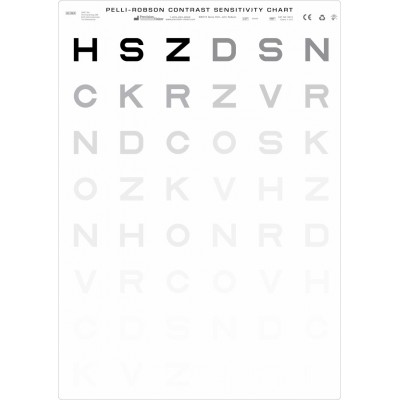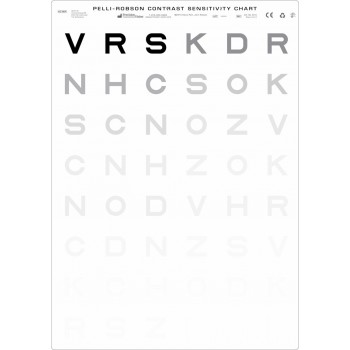- 50% SALE
- Anatomy of the Eye
- Domiciliary
- Illuminated Cabinets
- Low Vision Aids
- New Products
- Charts & Distance Tests
- COVID
- Clinical Trials Products
- Dispensing & Workshop
- Field Screening
- General Refraction
- Amsler Chart
- Autorefractors & Keratometers
- Bagolini Striated Lenses
- Cardiff Cards
- Clip-on Occluder
- Colour Tests
- Cross Cylinders
- Domiciliary
- Filter Bars
- Fixation Sticks
- Halberg Clips
- Lens Confirmation Tests
- Maddox Phoria Measure
- Maddox Wing Test
- Near Vision
- Occluders
- Optician Starter Kit
- Optokinetic Drum
- Paddle Retinoscopy Rack Set
- Pen Torch
- Polarising Visor
- Prisms & Prism Bars
- Refracto-Rack
- Stereo Tests
- Trial Frames
- Trial Lens Sets
- Trial Lens Spares
- Volk & Ocular Lenses
- Furniture
- Scopes & Loupes
- Sports Vision
Pelli-Robson Contrast Sensitivity Charts
Pelli-Robson Contrast Sensitivity Charts
Features Traditional Sloan Optotypes. For use at 100 cm (1m). Includes two charts which may be wall or easel mounted and score sheets.
Acuity Level 40M (20/320) at 1 Meter.
Illumination of 85 cd/m² is key to good results
Designed by DG Pelli, JG Robson and A J Wilkins, because they see contrast sensitivity as a realistic assessment of how well the patient sees large faint objects.
The chart follows the luminance, font, and letter spacing recommendations of the Committee on Vision of the National Academy of Sciences and National Research Council (Adv. Ophthal 41, 103-148, 1980).
The letter sequences are organized into groups of three (triplets) with two triplets per line. Within each triplet, all letters have the same contrast. The contrast decreases from one triplet to the next, even within one line.
The testing of contrast sensitivity on a regular basis is key to detecting early signs of diseases such as Parkinson’s, Glaucoma, and Cataracts. By testing with several different contrast levels configured together, the patient’s contrast sensitivity level is better assessed and records will be more precise.







